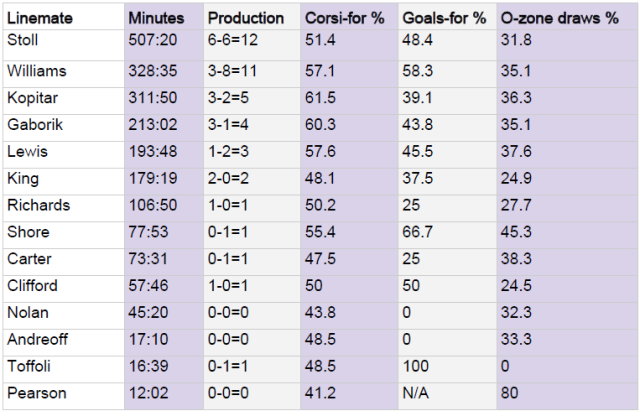After establishing career-highs with 33 goals and 60 points in 2007-08, team captain Dustin Brown enjoyed a string of consistent productivity between 2008-09 and 2012-13 with a range of production between 51.7 points (prorated from 2012-13) and 57 points (2010-11).
Since then, Brown has taken a significant hit in his individual production. With 27 points in each of the last two seasons – tied in part to a sharply diminished shooting percentage – Brown has now seen his total goals and points per game fall in each of the past three seasons.
There are unquantifiable aspects of Brown’s game that do matter. As a two-time Stanley Cup winner, he has experience that few players across the league could match. He is a catalyzing ingredient of the collective group’s determination and resolve, and clearly had his fingerprints over so many of the intangibles that rose to the surface during the 2014 playoff comebacks and Stanley Cup run.
Independent of what Brown has done in the past, his 2014-15 season produced some interesting if slightly concerning numbers. His 5.87% shooting percentage and .986 PDO were career-lows. His -1.2% Corsi-rel (rate of driving play comparable to the rest of his teammates) was a negative for only the second time in his career. Perhaps of greater concern: the Kings scored only 1.7 goals per 60 minutes while he was on the ice, the lowest rate since his 19-year-old rookie season.
How much of his production dip was caused by the partners he skated with? How much of his production dip was caused by simply poor luck? Let’s consult this handy LAKI chart, which tracks 5×5 production and possession rates amongst forwards Brown played with.
Observations (all numbers use 5×5 data):
-Brown was at his most productive when skating on a line with Justin Williams. His average of one point for every 29:52 of ice time alongside Williams was his best rate alongside any Kings forward he played a meaningful amount of time with. Ditto for his 58.3% goals-for percentage. The only problems? Williams, like Brown, was also an option to play alongside Marian Gaborik and Anze Kopitar, and Kopitar and Gaborik’s Corsi-for percentage alongside Williams (59.7% / 63.0%) weren’t really distinguishable from their rates alongside Brown (61.5% / 60.3%). Also, Williams is eligible to become an unrestricted free agent on July 1. Really, Gaborik and Kopitar more or less were equally comfortable playing with either Williams or Brown from a possession standpoint.
-From a production standpoint, Williams had superior rates alongside Gaborik and Kopitar. When Williams was on the ice with Gaborik, the Kings accounted for 66.7% of total goals scored. When he was on the ice with Kopitar, the Kings scored 60.0% of all five-on-five goals. When Brown was on the ice with Kopitar, the Kings scored only 39.1% of all goals. When he was on the ice with Gaborik, 43.8% of all goals were scored by the Kings.
-Given that Brown etched out a 61.5% Corsi-for rating with Kopitar and 60.3% with Gaborik, there was clearly poor luck involved. The trio drove play towards the attacking end about as well as could reasonably be expected but simply could not establish consistent offensive production.
-Considering that both Jarret Stoll and Williams are bound for unrestricted free agency and may very well play elsewhere next season, Brown once again may see elevated usage alongside Gaborik and Kopitar. If we’re basing any decisions five months from now on limited data from this past season, how about a look alongside Nick Shore? Los Angeles scored two thirds of the five-on-five goals in the very limited time Brown and Shore were on the ice together while maintaining a healthy possession rate (that was buoyed by beginning 45.3% of shifts in the offensive zone). There’s nowhere near enough of a sample size here, but it’s something to consider once we begin tracking lines and pairings during training camp.
Conclusion
Dustin Brown was most productive when paired with Jarret Stoll and Justin Williams, though either poor luck or some other variable limited his production when he skated alongside Anze Kopitar and Marian Gaborik. Brown is a versatile player capable of playing on the left or right wing and slotting anywhere in the top three lines, so it’s misguided to expect any 82-game regularity in where he plays and who he plays with.
Data collected by stats.hockeyanalysis.com, Puckalytics and War on Ice.




Rules for Blog Commenting
Repeated violations of the blog rules will result in site bans, commensurate with the nature and number of offenses.
Please flag any comments that violate the site rules for moderation. For immediate problems regarding problematic posts, please email zdooley@lakings.com.